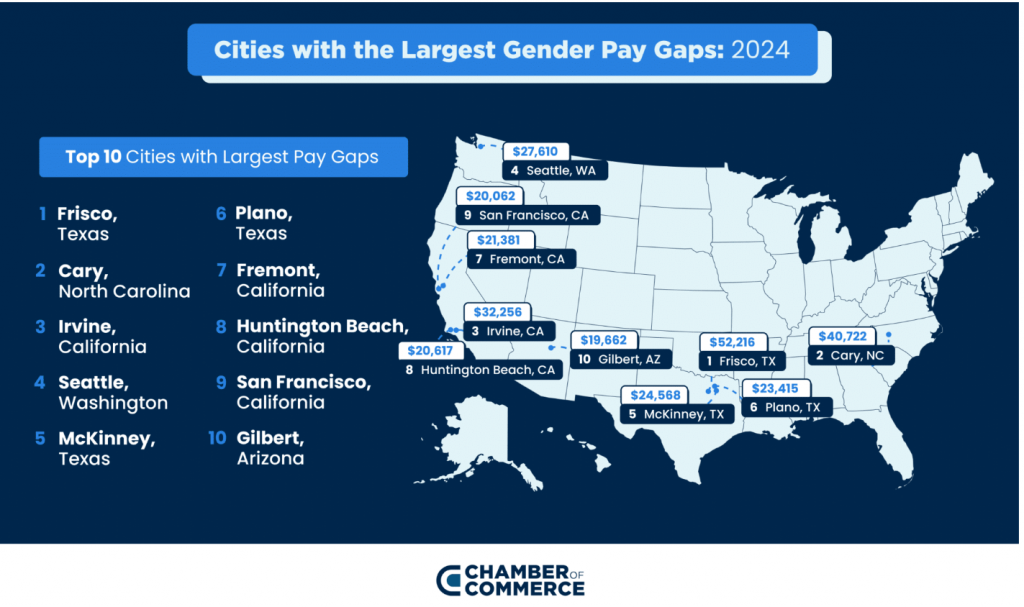Payroll
10 U.S. Cities With the Largest Gender Pay Gaps
Cities in Texas and California have some of the country’s largest pay gaps between men and women, a new report found.
Mar. 13, 2024

By Chris Morris, Fast Company (TNS)
March 12 is Equal Pay Day in the U.S., a representation of the additional number of days women must work in order to match the amount men earned last year. But in some cities, it could take even longer.
A report from product research company, ChamberofCommerce.org, using data from the U.S. Census, examines which U.S. cities have the dubious honor of having the largest gender pay gaps. Four of the top 10 cities are in California, with Texas claiming three of the other top 10 spots. And those three Texas cities are all within 20 miles of each other.
Frisco, Texas, a suburb of Dallas-Fort Worth, leads the list, with women making just 56.2% of men’s earnings. Median income for men in the city stands at $119,310, but women’s median earnings are just $67,094—a gap of more than $52,000 per year. The nearby cities of McKinney and Plano are fourth and fifth, with pay gaps of $24,568 and $23,415, respectively. In both cities, women earn just 71% of what men do.
California’s entries on the list are split between the San Francisco and Los Angeles areas. Irvine was third on the list. Women in that city earn 73.4% of what men do, which works out to a $32,256 gap. Nearby Huntington Beach posts a gap of $20,617, as women earn 78.5% of what men do.
And two cities in the San Francisco Bay area rank seventh and ninth. Fremont’s pay gap is $21,381, while San Francisco itself has one of $20,062.
Cary, North Carolina, home to Epic Games and a bedroom community of Raleigh, is the surprising runner-up when it comes to pay inequity, ranking second overall in the country. Women earn just 61.9% of what men do, resulting in a gap of $40,722.

Nationally, on average, women must work 14.5 months to make the same amount a man earns in 12 months, according to the National Committee on Pay Equity. Put another way, women earn just 84 cents for every dollar a man does. That number goes even lower when broken out by demographic. Native and Indigenous women receive just 55 cents to every dollar, making their equal pay day November 21.
Other factors, including age, occupation, disabilities, and level of education also affect the size of the actual gap. Also, it often depends on the industry.
People in the legal field have the largest gap, with women earning just 53.5% of what men do, resulting in a gap of nearly $70,000 per year. Health practitioners have a nearly $38,000 gap and women in management roles earn, on average, $23,023 less than their male peers.
While many companies are working to shrink or even erase the pay gap, that’s not carrying over to every city. In three locations, the pay gap increased five figures from 2021 to 2022 (the most recent data available). Frisco, Texas saw it jump by $12,357. Yonkers, NY’s gap increased $10,957. And Aurora, CO, saw the gap widen by $10,770 in that 12-month period.
2023 isn’t looking a lot better financially for women in the workplace. A CNBC survey reports that the number of women who secured pay raises this year was just 39%, compared to 44% a year ago. And 17% of the women CNBC spoke with said their salary is now lower than it was a year ago.
Globally, there is some cause for guarded optimism, though. While no country has yet achieved gender parity, some are getting close. The top nine countries in a United Nations report—Iceland, Norway, Finland, New Zealand, Sweden, Germany, Nicaragua, Namibia, and Lithuania—have closed at least 80% of their gap, with Iceland closing the gap by 91.2%.
______
Fast Company © 2024 Mansueto Ventures LLC. Distributed by Tribune Content Agency LLC.
